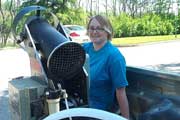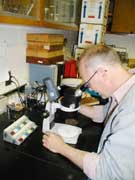|
|
 |
||||
|
Volume 13, Issue 18 ~ May 5-11, 2005
|
|||||
As mosquito season returns, so do mosquito fighters by Debra George Siedt Utopia: An ideally perfect place; an ideal commonwealth whose inhabitants exist under seemingly perfect conditions. That’s what Chesapeake Country would be had nature not given us mosquitoes. Anne Arundel and Calvert counties are not the worst of it. Improbable though it seems, Worchester and other counties on the Eastern Shore have a greater mosquito problem than we do. Coastal plains soils, like those in the Shore counties, do not drain well, creating the perfect environment for mosquitoes. Either side of the Bay, combating the blood-sucking, ankle-biting pests keeps us humble and resourceful. Compare our plight to Chautauqua, New York. There, in a gated, private lakefront community, people lazily spend evening hours outside with no fear of chemical repellents like DEET. But there is always a price for life without mosquitoes. In this community it’s bats. Chautauqua works hard to maintain a substantial bat population. The bats take up residence in attics, and people don’t mind cleaning up their droppings, all for the sake of the greater good, a life free from itchy bites. Back in Maryland, rather than deal with tons of guano, most counties depend on the resourcefulness of the Maryland Department of Agriculture for trying to keep this insect nuisance in check. Cyrus Lesser, chief of the state’s mosquito control program and a working entomologist since 1976, blames his father for his fascination with bugs. Lesser’s father, a biology teacher, loved to send his sons outside to study and identify things in nature. “I get to participate in a lot of nature things that I liked as a kid,” said Lesser of his job. Tracking Mosquitos Nowadays, Lesser’s job has him inside as well as out, running the 47-year-old statewide, voluntary program for counties — which contributes up to 50 percent of the cost for the program — and communities. The state’s contribution of $3 million is distributed to every county, with the exception of Garrett, which has no mosquitoes to speak of. Calvert, Queen Anne’s and Caroline counties receive state funds but manage their own mosquitoes. Supervising 20 mosquito suppressors, 60 trucks and two mosquito-spraying aircraft fills more of Lesser’s day than hand-to-hand combat with winged predators. “I get out in the field every chance I get,” Lesser said. “We’re all subject to strapping on backpacks. We’ll be flying and I’ll be in the right-hand seat with the pilot. I’ll stock fish or push papers in Annapolis, even though that’s my least favorite part. I also get to work with a lot of people and make a positive impact.” The backpack part of mosquito abatement begins with surveillance. Many communities, including the 180-some in Anne Arundel County, choose to participate in the surveillance program to monitor for adult mosquitoes. It’s a no-swatting surveillance, based on watching for larvae and keeping an eye on ditches, wetlands and stormwater drains. If the area has larvae that pose a health threat or enough that could result in a large population, it’s treated with insecticide or a growth regulator. Larvicides — insecticides that are used to treat mosquitoes — are applied directly to water in freshwater marshes, salt marshes, woodland pools, ditches and dredged areas. Each of the larvicides requires a permit from the Maryland Department of the Environment. Among them is Altosid, with an active ingredient of methoprene, which cannot be used in fish-inhabited waters. Two other bacterial larvacides are also used, Vectolex and Teknar. While none of the larvicides can be called safe, according to Lesser, they are used following guidelines from the EPA. Mosquito-eating fish also help. Mosquito fighters catch the fish in the natural habitats and transfer them into stormwater ponds, artificial wetlands, abandoned pools and some sewage plants. But these fish cannot be introduced in native environments because they could displace native species. The plan at this stage is to deal with the mosquito eggs before they breed biting adults. “If there are no adults, you won’t be bothered,” said Lesser. “It’s quite effective.”
If you’re not lucky enough to live in an adult-free zone, however, your community may sign on for adult mosquito control. Here, too, surveillance is the first, labor-intensive step. Among the techniques mosquito control specialists use to check the adult population in our communities is offering themselves as bait, then counting the mosquitoes that land on them. “We do an assessment of the number of mosquitoes that attempt to feed,” said Lesser, showing the stoicism required for a job that endures a landing rate of a mosquito or more each minute. Light traps are also set up at night, and if more than 10 female mosquitoes are caught per trap, the area is sprayed. And cups are dipped into stagnant water. The state sprays if any larvae show up, while Calvert County holds off spraying until five are caught. If mosquito findings cross the threshold, communities may sign on for mosquito spraying. In most communities, the decision to spray will bring spray trucks through the streets, but under certain conditions, the state breaks out the big guns, insecticide-spraying aircraft. They’re used primarily in large areas where trucks can’t go or in rural communities with few streets. Controllers also look for evidence of mosquito-born diseases, including West Nile virus, by trapping the pests, which are then sent to the state health department for testing. If there is a threat of West Nile or if the landing rate is greater than 12 mosquitoes per minute, the planes fly in. “We want to quickly treat the large area,” Lesser said. Bacillus thuringiensis, a naturally occurring insecticide — favored by organic gardeners and genetic agroengineers — has been used since 1996, when an earlier insecticide, Malathion, was replaced amid worries of toxicity. The state sprayed some 2,300 gallons of insecticide last year alone. All the work is paying off … sort of. The good news, said Lesser, is that the native mosquito population has been dropping since 1976. The bad news, however, is that another, more difficult mosquito, the Asian tiger, has been growing in numbers throughout the state. Unlike other species of mosquitoes, the Asian tiger is very adaptable and thrives in more urbanized areas, such as northern Anne Arundel County. In its native Asia, this exotic mosquito breeds in the cavities of bamboo. Hereabouts the Asian tiger creates its habitat in just about any enclosed environment or small containers. Populated areas have plenty of buckets, wheelbarrows and other containers that double as breeding grounds for the mosquitoes. “They are a very successful mosquito,” said Lesser. “They have unique habits of using these containers.” Asian tigers — now predominately found in Prince George’s, Baltimore and northern Anne Arundel counties — began appearing in 1986. “The number-one mosquito for pests and infections,” says Lesser, they’re “far worse” than they were 20 or 30 years ago. While there are plenty of mosquitoes, “there aren’t,” Lesser laments, “enough [controllers] to visit everyone’s back yard.” So an ever-larger part of his job is teaching us that mosquitoes are dangers as well as nuisances. Lesser’s job as a mosquito-awareness educator has him out in the field, too, organizing community workshops to train citizens in the communities to help reduce breeding sites by removing stagnant water. “It’s impossible to remove all the breeding sites because there aren’t enough resources to visit everyone’s back yard,” he said. “Landowners need to do their own source reduction.” He’s reaching out over the airwaves, too. Radio listeners and television watchers will soon be hearing a newly produced public service announcement on why the Asian tiger mosquito is such a danger. The latest outreach program was also airborne. On April 29, a mosquito-control airplane debuted in Cambridge. The plane uses GPS, global positioning satellite, to help set its targets. It can also fly at night, when mosquitoes are most active, to spray. As mosquito season returns with all its attacks and counterattacks, we might wish we were living in Chautauqua with no mosquitoes in sight. In that utopia, we wouldn’t have to worry about bites, sprays or running out of citronella candles. But we’d be scooping up guano. |
|||||
|
© COPYRIGHT 2004 by New Bay Enterprises, Inc. All rights reserved. |

